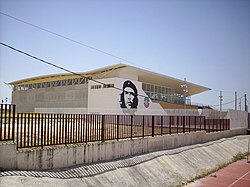PAK3
PAK3PAK3(p21-activated kinase 2, 베타-PAK)는 그룹 I PAK 계열의 진화 보존 세린/트레오닌 키나제 중 하나이다.[5][6][7]PAK3는 뉴런 세포에서 우선 발현되며 시냅스 형성과 가소성, 정신지체 등에 관여한다.[10][11]
디스커버리
PAK3는 처음에 무두질 섬유블라스트 cDNA 라이브러리와 무두질 배아 cDNA 라이브러리에서 복제되었다.[8][9]다른 그룹 I PAKs와 마찬가지로 PAK3도 활성화된 Cdc42와 Rac1에 의해 자극을 받는다.
유전자와 스플라이스 변형
내가족 최장수 그룹인 인간 PAK3 유전자는 길이가 283kb이다.PAK3 유전자는 22개의 exon으로 구성되어 있으며, 이 중 6개의 exon은 5'-UTR용이며 13개의 대체 splits를 생성한다.PAK3 대본 중 11 대본은 길이 181-아미노산부터 580-아미노산까지의 단백질 코딩을 위한 것이고, 나머지 2 대본은 비 코딩 RNA이다.[12]뮤린 PAK3 유전자는 10개의 성질을 가지고 있으며, 아미노산 544개, 아미노산 559개에서 6개의 단백질을 코드화하고, 23개에서 366개까지 4개의 작은 폴리펩티드를 함유하고 있다.
단백질 도메인
PAK1과 마찬가지로 PAK2는 p21 바인딩 도메인(PBD)과 자동 수신 도메인(AID)을 포함하며 비활성 순응으로 존재한다.[13]
활성화제 및 억제제
PAK3 활동은 Dbl, Cdc42 및 Cool-2와 [14][15]AP1 전사 인자에 의해 자극된다.[16]Dbl 또는 Cdc42와 같은 업스트림 자극기에 의한 PAK3 활성 자극은 p50 (Cool-1) [15]PAKs의 PAN 억제제인 FRAX597에 의해 억제된다.[17]
기능들
PAK3는 신경내분비/카르시노이드 종양에서 과다압박된다.[18]PAK3는 시냅스 형성과 가소성에 중요하며 정신지체에도 기여하는 것으로 나타났다.[10]또한, PAK3 유전자의 모든 돌연변이는 비신드롬 X 연계 정신지체와 연관되어 있다.[11]
메모들
이 글의 2016년 버전은 외부 전문가가 이중 출판 모델로 업데이트했다.해당 학술적 동료 검토 기사는 진에 게재되었으며, 다음과 같이 인용할 수 있다. Rakesh Kumar; Rahul Sanawar; Xiaodong Li; Feng Li (19 December 2016). "Structure, biochemistry, and biology of PAK kinases". Gene. Gene Wiki Review Series. 605: 20–31. doi:10.1016/J.GENE.2016.12.014. ISSN 0378-1119. PMC 5250584. PMID 28007610. Wikidata Q38779105. |
참조
- ^ a b c GRCh38: 앙상블 릴리스 89: ENSG000077264 - 앙상블, 2017년 5월
- ^ a b c GRCm38: 앙상블 릴리스 89: ENSMUSG000031284 - 앙상블, 2017년 5월
- ^ "Human PubMed Reference:". National Center for Biotechnology Information, U.S. National Library of Medicine.
- ^ "Mouse PubMed Reference:". National Center for Biotechnology Information, U.S. National Library of Medicine.
- ^ Knaus UG, Morris S, Dong HJ, Chernoff J, Bokoch GM (July 1995). "Regulation of human leukocyte p21-activated kinases through G protein--coupled receptors". Science. 269 (5221): 221–3. doi:10.1126/science.7618083. PMID 7618083.
- ^ Manser E, Chong C, Zhao ZS, Leung T, Michael G, Hall C, Lim L (October 1995). "Molecular cloning of a new member of the p21-Cdc42/Rac-activated kinase (PAK) family". The Journal of Biological Chemistry. 270 (42): 25070–8. doi:10.1074/jbc.270.42.25070. PMID 7559638.
- ^ Kumar A, Molli PR, Pakala SB, Bui Nguyen TM, Rayala SK, Kumar R (July 2009). "PAK thread from amoeba to mammals". Journal of Cellular Biochemistry. 107 (4): 579–85. doi:10.1002/jcb.22159. PMC 2718766. PMID 19350548.
- ^ a b Bagrodia S, Taylor SJ, Creasy CL, Chernoff J, Cerione RA (September 1995). "Identification of a mouse p21Cdc42/Rac activated kinase". The Journal of Biological Chemistry. 270 (39): 22731–7. doi:10.1074/jbc.270.39.22731. PMID 7559398.
- ^ a b Burbelo PD, Kozak CA, Finegold AA, Hall A, Pirone DM (May 1999). "Cloning, central nervous system expression and chromosomal mapping of the mouse PAK-1 and PAK-3 genes". Gene. 232 (2): 209–15. doi:10.1016/s0378-1119(99)00110-9. PMID 10352232.
- ^ a b Boda B, Alberi S, Nikonenko I, Node-Langlois R, Jourdain P, Moosmayer M, Parisi-Jourdain L, Muller D (December 2004). "The mental retardation protein PAK3 contributes to synapse formation and plasticity in hippocampus". The Journal of Neuroscience. 24 (48): 10816–25. doi:10.1523/jneurosci.2931-04.2004. PMC 6730202. PMID 15574732.
- ^ a b Allen KM, Gleeson JG, Bagrodia S, Partington MW, MacMillan JC, Cerione RA, Mulley JC, Walsh CA (September 1998). "PAK3 mutation in nonsyndromic X-linked mental retardation". Nature Genetics. 20 (1): 25–30. doi:10.1038/1675. PMID 9731525. S2CID 16041444.
- ^ Kreis P, Rousseau V, Thévenot E, Combeau G, Barnier JV (August 2008). "The four mammalian splice variants encoded by the p21-activated kinase 3 gene have different biological properties". Journal of Neurochemistry. 106 (3): 1184–97. doi:10.1111/j.1471-4159.2008.05474.x. PMID 18507705.
- ^ Kumar R, Li DQ (2016). PAKs in Human Cancer Progression: From Inception to Cancer Therapeutic to Future Oncobiology. Advances in Cancer Research. Vol. 130. pp. 137–209. doi:10.1016/bs.acr.2016.01.002. ISBN 9780128047897. PMID 27037753.
- ^ Bagrodia S, Bailey D, Lenard Z, Hart M, Guan JL, Premont RT, Taylor SJ, Cerione RA (August 1999). "A tyrosine-phosphorylated protein that binds to an important regulatory region on the cool family of p21-activated kinase-binding proteins". The Journal of Biological Chemistry. 274 (32): 22393–400. doi:10.1074/jbc.274.32.22393. PMID 10428811.
- ^ a b Bagrodia S, Taylor SJ, Jordon KA, Van Aelst L, Cerione RA (September 1998). "A novel regulator of p21-activated kinases". The Journal of Biological Chemistry. 273 (37): 23633–6. doi:10.1074/jbc.273.37.23633. PMID 9726964.
- ^ Holderness Parker N, Donninger H, Birrer MJ, Leaner VD (2013). "p21-activated kinase 3 (PAK3) is an AP-1 regulated gene contributing to actin organisation and migration of transformed fibroblasts". PLOS ONE. 8 (6): e66892. doi:10.1371/journal.pone.0066892. PMC 3688571. PMID 23818969.
- ^ Licciulli S, Maksimoska J, Zhou C, Troutman S, Kota S, Liu Q, Duron S, Campbell D, Chernoff J, Field J, Marmorstein R, Kissil JL (October 2013). "FRAX597, a small molecule inhibitor of the p21-activated kinases, inhibits tumorigenesis of neurofibromatosis type 2 (NF2)-associated Schwannomas". The Journal of Biological Chemistry. 288 (40): 29105–14. doi:10.1074/jbc.m113.510933. PMC 3790009. PMID 23960073.
- ^ Liu RX, Wang WQ, Ye L, Bi YF, Fang H, Cui B, Zhou WW, Dai M, Zhang J, Li XY, Ning G (August 2010). "p21-activated kinase 3 is overexpressed in thymic neuroendocrine tumors (carcinoids) with ectopic ACTH syndrome and participates in cell migration". Endocrine. 38 (1): 38–47. doi:10.1007/s12020-010-9324-6. PMID 20960100. S2CID 33359058.








